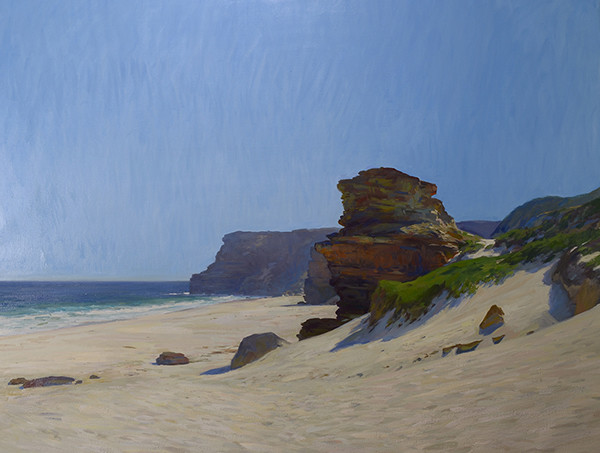Here is a short, two minute, time lapse video of a large studio landscape I painted over the last couple of weeks. After buying a ton of winter gear for plein air snowscapes we’ve had a really warm, snow-free winter, and I’ve had colds and flu for two months and been stuck inside the whole time. On the bright side, I did manage to get a lot of studio work finished.
This painting was enlarged from a plein air sketch I originally did on Diaz Beach at the Cape of Good Hope in South Africa two years ago. I also did a number of drawings to design the composition and I had photographs that I used for information in the areas which my sketch didn’t cover. Even though I had thought out the composition that I wanted with drawings, as you can see in the video I often make changes after I get started as it is easier to see what works and what doesn’t on the large canvas.
I’ve added some annotations in the video to explain some of my decisions while working and I explain some compositional rules. I feel it’s important to reiterate that, while I believe it’s important to understand rules in painting, often the paintings that we remember -the ones that really stay with us for a long time- are precisely the ones which break those rules.
That said, the compositional error of having major elements all the same size is something I do feel hurts a lot of paintings, some of mine included. It is something artists should be aware of.

Diaz Beach, the Cape of Good Hope. 120 x 150 cm, oil on linen.
Thank you so much for sharing your thinking process. It is so helpful.
Lovely use of the study to create a larger piece. It’s inspiring to see.
Is there a reason that you leave the brush strokes in the sky areas so obvious?
Thanks Tom. The brushstrokes in the sky are just my own taste. I got the idea from Charles-François Daubigny’s skies, which have a similar handling. If I smooth out the brushstrokes I find it looks plasticky, but my gallerists often complain about my skies too, and ask me to ditch the really egregious areas.
This is great! I really enjoy seeing the annotations with regards to your thought process. I love your brush stroke skies, always have energy to them.
Thank you for your video. Did you use the same method when painting the plein aire version? When painting the studio version did you use indirect painting, many layers , drying, glazing?
There will be some glazing later. In plein air work I do a bit of glazing later in the studio, but not as much as with a full studio piece.
Marc, are you scraping down the entire painting or just the edges/borders between colors?
Everywhere where I think there is too much paint, which is usually the whole painting. Scraping just the borders would leave a strange effect later. If an area is perfect I wouldn’t scrape it down, but that rarely happens.
Beautiful painting and I especially love the subtle variations of color in the sand.
I noticed that you don’t use the orange underpainting you normally use with your plain air paintings. Is it not useful while working in the studio ?
I never use the orange (transparent red oxide) on canvas. I use it really just with the panels as I need to seal them anyway. It’s more of a side-effect of needing to prepare the gesso in a certain way, rather than my preferred working method.
Yeah…Why no burnt sienna for the studio versions?
what size brushes did you use to paint such a big canvas
Awesome. I love boldly brushed skies too. They have more dazzling energy.
Thank you for giving us this look into your painting process. Speaking of compositional issues, why do you so typically make the sky and the land area equal? To me, this is also a compositional issue. What happened to the rule of thirds?
My horizon is pretty low. If I went much lower the painting would have too much sky. I’m trying to show enough of the foreground to (hopefully) make the viewer feel like they’re in the scene.
Nice video and Great painting….!!!best painter
Waitin’ for the hi-res picture on you Tmblr…
Great to see this, and your process notes are very informative! I admire impasto marks, when you scrape off do you have trouble building up the paint? I’ve been using just paint, with no medium, and assume the paint from previous days, will help with achieving texture buildup. But you are right, it can be a mess, with ridges underneath going in different directions. But single layers seem to ‘settle’ flatly, with no textural contrast. When you want an impasto mark, do you really have to load that brush? Thanks, sorry for the long question.
Hi Judy, I only scrape down until I’m sure of my shapes, then I will add an occasional impasto. I usually use less medium and more paint as I progress, and I will load up the brush for impastos, or even use a palette knife if I need more paint.